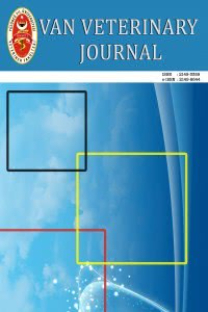Seroprevalence of Equine Brucellosis in Southeast Turkey
Bu çalışmada, Türkiye’nin güneydoğusundaki tektırnaklı hayvanlarda brusellozis seroprevalansının belirlenmesi amaçlandı. Sanliurfa ve Diyarbakır bölgesinde bulunan eşekler (n=1172) ve atlardan (n=782 at) 1954 serum örneği toplandı. Serumlar, Brucella antikorlarının varlığı yönünden Rose Bengal plate test (RBPT) ile incelendi. RBPT ile test edilerek pozitif veya şüpheli bulunan serumlar, serum aglutinasyon testiyle (SAT) ile incelendi.. RBPT ile test edilerek pozitif veya şüpheli bulunan serumlar SAT ile incelendi. Brusellozis seroprevalansı atlarda RBPT ile %13.68, SAT ile %0.51, eşeklerde RBPT ile %6.05 ve SAT ile %0.25 olarak bulundu. Sanliurfa bölgesinde 9 (%5.69), Diyarbakır bölgesinde 62 (%6.11) eşek RBPT ile pozitif olarak bulunurken, Sanliurfa bölgesinde 99 (%18.71), Diyarbakır bölgesinde ise 8 (%3.16) at RBPT ile pozitif olarak saptandı. Ayrıca, Sanliurfa’da 4 (%0.75) at ve Diyarbakır’da 3 (%0.29) eşek SAT ile seropozitif olarak belirlendi. Sonuç olarak, brusellozisin Sanliurfa ve Diyarbakır bölgesinde yaşayan at ve eşekler arasında yaygın bir infeksiyon olmasa da, diğer duyarlı hayvanlar ve insan sağlığı bakımından risk oluşturabileceği düşünüldü. Bu nedenle, kamu sağlığı açısından bruselloz kontrol programına tektırnaklıların da dahil edilmesinin yararlı olabileceği sonucuna varıldı.
Anahtar Kelimeler:
antikor, brusellozis, hastalık tetkiki, epidemiyolojik araştırmalar, rose Bengal, serolojik etüdler, eşek, at, Brucella, aglütinasyon testleri, teşhis, hastalık yaygınlığı, epidemiyoloji, bağışıksal tanı, seroprevalans, Türkiye
Türkiye’nin Güneydoğusundaki tektırnaklı hayvanlarda brusellozisin seroprevalansı
In this study, it was aimed to determine the seroprevalence of brucellosis in equine in southeast Turkey. A total of 1954 sera samples were collected from donkeys (n=1172), horses (n=782) raised in Sanliurfa and Diyarbakir provinces. The sera were tested for the presence of anti-Brucella antibodies by using Rose Bengal Plate test (RBPT). Positive or doubtful sera by RBPT were further examined by Serum Agglutination test (SAT) for confirmation. The seroprevalence of brucellosis in horses was 13.68% and 0.51% by RBPT and SAT, respectively. The seroprevalence of brucellosis in donkey was 6.05% and 0.25% by RBPT and SAT, respectively. In Sanliurfa and Diyarbakir provinces 99 (18.71%) and 8 (3.16%) of the horses, respectively, were defined as seropositive by RBPT, while 9 (5.69%) and 62 (6.11%) of the donkeys from Sanliurfa and Diyarbakir provinces, respectively were defined as seropositive by RBPT. On the other hand, 4 (0.75%) of the horses in Sanliurfa region and 3 (0.29%) donkeys in Diyarbakir region were defined as seropositive by SAT. Consequently, the results indicated that brucellosis is not widely distributed among horses and donkeys raised in Sanliurfa and Diyarbakir provinces. However it can threat health of other sensitive animals, and humans. Including horses and donkeys in this region into brucellosis control program may be beneficial for public health.
Keywords:
antibodies, brucellosis, disease surveys, epidemiological surveys, rose Bengal, serological surveys, donkeys, horses, Brucella, agglutination tests, diagnosis, disease prevalence, epidemiology, immunodiagnosis, seroprevalence, Turkey,
___
- Abo-Shehada MN (2009). Seroprevalence of Brucella species in equids in Jordan. Vet Rec, 165, 267-268.
- Acosta-González RI, González-Reyes I, Flores-Gutiérrez GH (2006). Prevalence of Brucella abortus antibodies in equines of a tropical region of Mexico. Can J Vet Res, 70, 302-304.
- Alton GG, Jones LM, Angus RD, Verger JM (1988). Techniques for the brucellosis Laboratory. Paris: Institut National de La Recherche Agronomique, 190.
- Carrigan MJ, Cockram FA, Nash GV (1987). Brucella abortus biotype 1 arthritis in a horse. Aust Vet J, 64, 190.
- Cohn NO, Carter GK, Mc Millan WC (1992). Fistulous withers in horses: 24 cases (1984-1990). J Am Vet Med Assoc, 201, 121-124.
- Collins JD , Kelly WR, Twomy T, Farrlly BT, Whitty BT (1971). Brucella – associated vertebral osteomyelitis in thoroughbred mare. Vet Rec, 88, 321-326.
- Corbel MJ (1997). Brucellosis: an overview. Emerg Infect Dis, 3, 213-221. Denny HR (1972). Brucellosis in the horse. Vet Rec, 90, 86-91.
- Ehizibolo DO, Gusi AM, Ehizibolo PO, Mbuk EU, Ocholi RA (2011). Serologic Prevalence of Brucellosis in Horse Stables in Two Northern States of Nigeria. J Equine Sci, 22(1), 17–19.
- Göz Y, Babür C, Aydin A, Kiliç S (2007). Seroprevalence of toxoplasmosis, brucellosis and listeriosis in horses in Hakkari, eastern region of Turkey. Revue Med Vet, 158(11), 534-539.
- Hamoda FK, Montaser AM (1998). Clinico-epizootiological study on brucellosis in donkeys. Beni-Suef Veterinary Medical Journal, 8, 105-118.
- Hutchins DR, Lepherd EE (1968). The occurrence of agglutinins to Brucella abortus in horses. Aust Vet J, 44, 323-325. Izgur M, Akay O, Candas A, Inan A, Ayhan H, Esendal O (1998). Ankara’da at brusellozis’inin prevalansı üzerine bir çalısma. Etlik Vet Mikrobiol Derg, 6, 117-126.
- Mac Millan AP (1985). A retrospective study of serology of brucellosis in horses. Vet Rec, 117, 638-639.
- Nicoletti PL (2007). Brucellosis. In: Equine Infectious Diseases, edited by Sellon DC, Long, MT (Eds), 281-295, Saunders Elsevier, Missouri.
- Omer MK, Skjerve E, Holstad G, Woldehivet Z, Mac Millan AP (2000). Prevalence of antibodies to Brucella spp. in cattle, sheep, goats, horses and camels in the State of Eritrea; influence of husbandry systems. Epidemiol Infec, 125, 447-453.
- Solmaz H, Tutuncu M, Akkan HA, Aksakal A, Gulhan T, Boynukara B (2004). Brucellosis in horses around Van, Turkey. Indian Vet J, 81, 748-749.
- Tahamtan Y, Namavari MM, Mohammadi G, Jula GM (2010). Prevalence of Brucellosis in Horse North-East of Iran. J Equine Vet Sci, 30(7), 376-378.
- Wadood F, Ahmad M, Khan A, Gul ST, Rehman N (2009). Seroprevalence of Brucellosis in Horses in and Around Faisalabad. Pakistan Vet J, 29(4), 196-198.
- ISSN: 1017-8422
- Yayın Aralığı: Yılda 3 Sayı
- Başlangıç: 1990
- Yayıncı: Yüzüncü Yıl Üniv. Veteriner Fak.
Sayıdaki Diğer Makaleler
Babu NATH, Krishna ROY, Amir SHAIKAT, Subrata SHIL
Mohammad Al NOMAN, Amir SHAIKAT, Babu NATH, Subrata SHIL, Mohammad HOSSAN
Seroprevalence of Equine Brucellosis in Southeast Turkey
Epidemiology and economic aspects of foot and mouth disease in district Sahiwal, Punjab, Pakistan
Mahmood Ijaz GORSI, Muhammad ABUBAKAR, Muhammad Javed ARSHED
The effect of various concentrated feed mixtures on certain blood parameters in tuj lambs
Dilek ELMALI AKSU, METİN ÖĞÜN, OĞUZ MERHAN, İsmail KAYA
Turan KARACA, Şevket ARIKAN, Hakan KALENDER, İLKNUR PİR YAĞCI, MECİT YÖRÜK
Bleomisin uygulanan ratlarda CoQ10’ in tüylerdeki iz mineral düzeyleri üzerine etkisi
